
We are celebrating 15 years — and counting — of stories that are deeply researched and deeply felt, that build a historical record of what the city has been.
We are celebrating 15 years — and counting — of stories that are deeply researched and deeply felt, that build a historical record of what the city has been.
101 Spring Street is a proto-loft building, an example of the minimalist live/work spaces made fashionable by artists, who pioneered the idea of loft living as a form of adaptive reuse that is now a standard and desirable residential style. Constructed in 1870 by Nicholas Whyte, this building was the home and studio of artist Donald Judd from 1968 until his death in 1994. It is currently home to the New York City branch of the Judd Foundation, an organization dedicated to preserving the artist’s home and studio spaces. This week, the Judd Foundation, after three years of careful construction, preservation, and restoration work, has opened the building to the public through ticketed, guided tours. On Monday, look out for an interview with members of the restoration team in which the details of the history, restoration process, and adherence to Judd’s vision for the space are discussed, which will be published as one of the Architectural League’s weekly online features. Though the building provides critical insight into the life and work of one of the leading artists of the 20th century, its importance extends beyond the art historical. 101 Spring Street can be seen as a time capsule through which we can trace the development of a neighborhood over the past 50 years. Below, Yukie Ohta, SoHo native and author of The SoHo Memory Project, looks at the dramatic transformation of one corner of the city from a center for light manufacturing, to a desolate and dangerous wasteland, to one of the most affluent neighborhoods in New York. –V.S.
The area that is now called SoHo has gone by many other names: it was sometimes referred to as the Valley, because of its many low, five-story buildings bounded by areas of tall skyscrapers to the south and north. It was also known as Hell’s Hundred Acres, a name given to the neighborhood in 1956 by the fire commissioner after numerous firefighters lost their lives while attempting to contain massive fires raging in hundred-year-old storage buildings that either sat empty or were filled with rag storage, baled goods, paper rolls, and heavy machinery overloading sagging wooden floors. In August 1973, the Landmarks Preservation Commission designated the neighborhood the Cast-Iron Historic District. Today, there are approximately 250 buildings with cast-iron façades in New York City, many of them in SoHo and mostly dating from the mid- to late-1800s. Though these façades are familiar to anyone who has wandered through the streets south of Houston, one structure — the Judd Foundation’s 101 Spring Street, considered “the only single-use cast iron building left in SoHo” — has just been extensively restored to offer a glimpse into a particular moment in a neighborhood’s history, the process of an individual artist, and an architectural form that has proved flexible and resilient despite radical changes in the demographics and economics of the area.
An American invention, cast-iron façades were not only less expensive to produce than stone or brick, but also much faster and more efficient, as they were made in moulds, rather than carved by hand, and stuck to the face of buildings. The same mold could then be used for multiple buildings and a broken piece could easily be recast. Ornate cast-iron façades were originally used to spruce up pre-existing buildings, but were later used in new construction as well. Iron’s pliability allowed for ornate window frame designs, and the material’s strength could support large windows, high ceilings, and vast floor spans. The 6,000-square-foot facade of 101 Spring Street has 40 window bays that flood each open floor with ample daylight.
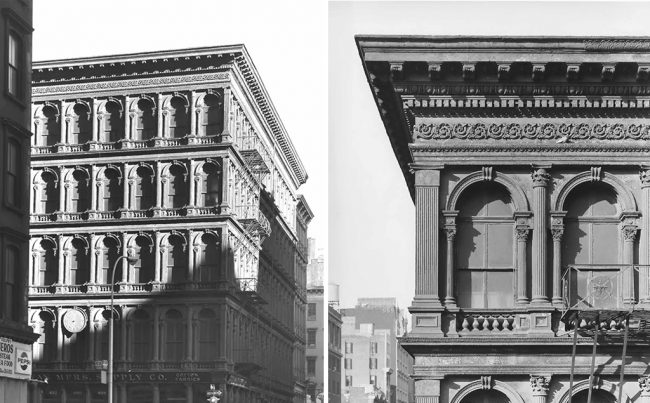
Haughwout Building | Photos: Historic American Buildings Survey, Library of Congress, Prints and Photographs Division
Until the 1960s, SoHo’s cast iron buildings were primarily used for manufacturing and warehousing goods. But, as modern industry came to require a different type of structure — a more spacious one-story building with large loading zones for long tractor-trailers — the verticality of the SoHo buildings proved to be inefficient for moving goods. And as electrical lighting became less expensive, the large windows of the cast-iron buildings no longer offered the same advantage.
De-industrialization and shifts in industrial technology did not pose the only threats to the neighborhood. Plans to build a highway connecting New Jersey and Brooklyn all but ensured the destruction of what is now SoHo and Little Italy. First put forth in the 1930s, the idea for the Lower Manhattan Expressway, or LOMEX, gained support in the 1950s and 1960s. Community opposition, however, put a stop to the project. The highway was never built.
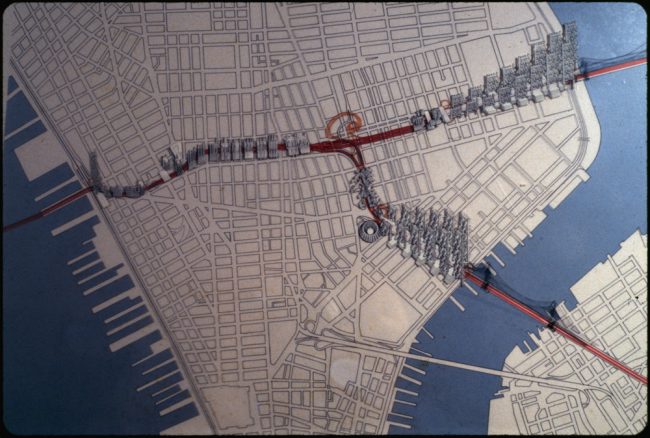
Proposed Lower Manhattan Expressway, c. 1967-1972, Color slide. | Image: Paul Rudolph Archive, Library of Congress Prints and Photographs Division
In 1962, a non-partisan civic organization dedicated to the advancement of good government called the City Club published a report titled “The Wastelands of New York City” that recommended a large part of what is now SoHo be razed, as “there are no buildings worth saving,” and replaced with new housing. The neighborhood’s iconic name is derived from a different report authored the following year, in which Chester Rapkin, an economic consultant for the City Planning Commission, argued for the viability of the area’s building stock. His findings, entitled “The South Houston Industrial Area” (also known as “The Rapkin Report”), maintained that while the number of businesses in the area had declined over the years, the old buildings still housed small industries that employed many low-income and minority workers and were also a still-viable tax revenue source for the city.
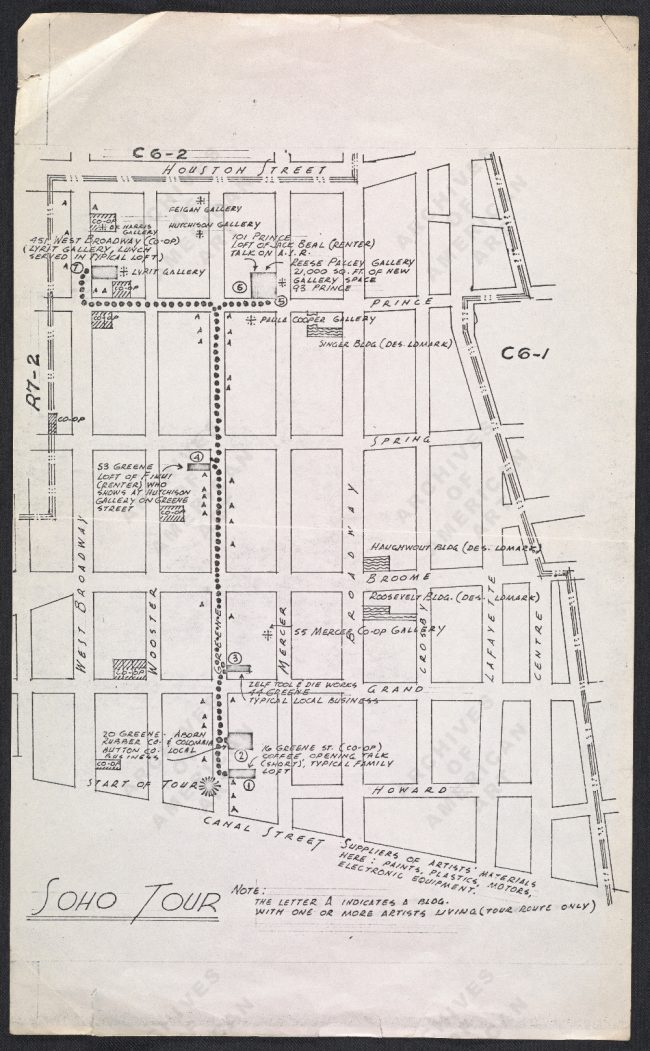
Map of SoHo tour | SoHo Artists Association Records, 1968-1978. Archives of American Art, Smithsonian Institution
Although these buildings were saved from demolition by the City Planning Commission, by the mid-1960s landlords in the area were left with empty lofts that were too small to be used for manufacturing, in an M1-5 neighborhood zoned only for light manufacturing and commercial — not residential — use. Many lofts remained empty for quite some time until artists began moving in to what had become a desolate, dirty, and dangerous area. These new residents lived illegally in raw industrial lofts they made habitable by installing bathrooms and taping plastic sheets over the windows to keep out the cold. Living conditions were often uncomfortable at best. The area was empty at night, the crime rate was high, and the streets were filthy, as there was no regular trash pickup. There were no schools or clinics, and no grocery stores or restaurants, save for a couple of diners open only for breakfast and lunch to serve the factory workers. It was a kind of no-man’s-land that even taxi drivers had trouble navigating. On the other hand, the small population and isolation from infrastructure and resources created a tight-knit community of residents. Everyone knew each other by name and looked after one other. Because there were so few public services, the community provided for themselves, opening restaurants for locals and forming community playgroups where neighbors often paid for goods and services with their time and involvement instead of cash.
Meanwhile, the Artists Tenants Association was working to prevent the eviction of New York City artists from non-residential buildings. The group, founded in 1961 amid the FDNY’s crackdown on fire safety and code violations and headquartered in Midtown, eventually secured Artist in Residence Status (AIR) for some artists. AIR allowed up to two families to reside in a factory building without changing its Certificate of Occupancy. Under this arrangement, residents were required to post a sign in the front of their buildings with the letters “AIR” and the floor on which they lived so that in the event of a fire, the fire department would immediately know which floors were inhabited. While the AIR program did not specifically apply to SoHo, it laid the groundwork for zoning changes to come.
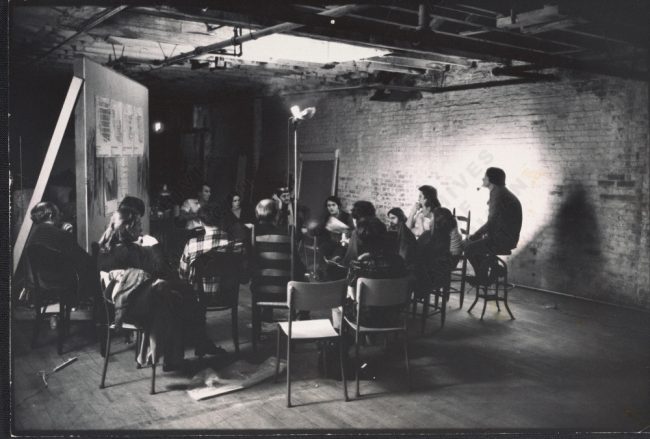
Meeting of SoHo Artists Association Planning Committee, discussing survey maps prior to the legalizations of loft living. | SoHo Artists Association Records, 1968-1978. Archives of American Art, Smithsonian Institution
By 1969, there were enough artists living in SoHo, many in artist cooperatives, to form an advocacy group called the SoHo Artists Association (SAA), predecessor of the SoHo Alliance, whose aim was to improve living conditions, legalize loft dwellings, and fight to keep SoHo an affordable place for artists to work. Through the SAA, as well as efforts of smaller resident groups (not everyone in SoHo was a member of the SAA, nor did they unanimously support its causes), the residents of SoHo sought to fill the gaps in city services.
During this period, the 1st Precinct of the NYPD, which includes SoHo, saw a dramatic rise in the number of murders, rapes, break-ins, and hold-ups. In response, the SAA initiated attempts to beef up neighborhood security by educating people about self-defense, providing whistles, lobbying for better lighting in public areas, and, most importantly, organizing patrols of the neighborhood. Another everyday “amenity” that the SAA succeeded in bringing to SoHo was curbside pickup of household and bulk garbage. The crowning achievement of the SAA, however, was the legalization of loft living in SoHo.
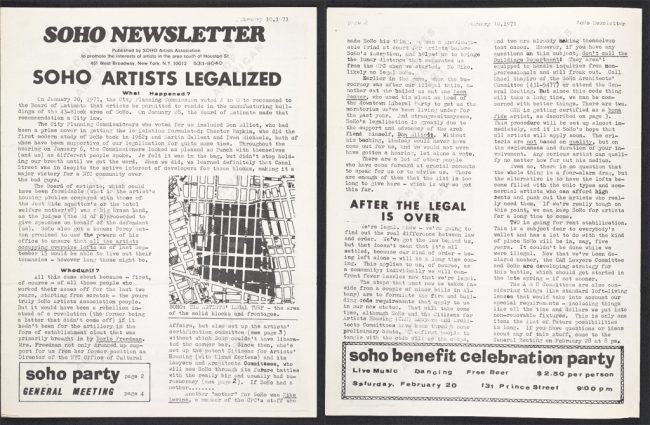
SoHo Newsletter, February 10, 1971 | SoHo Artists Association Records, 1968-1978. Archives of American Art, Smithsonian Institution
In 1969, the Department of City Planning conducted a survey of the entire M1-5 district that included SoHo and found that buildings over 5,000 square feet were primarily manufacturing sites and that buildings under 5,000 square feet were generally used for storage. Because artists tended to live in these smaller buildings, their presence did not threaten blue-collar jobs. As a result of these findings, new zones in the SoHo area, designated M1-5A and M1-5B, were established that permitted joint living-working quarters for artists in lofts that were smaller than 3,600 square feet. In January 1971, the Board of Estimate made it legal for certified artists to reside in the manufacturing buildings of SoHo and set a precedent for how other neighborhoods and cities would approach adaptive reuse of non-residential urban areas.
After 1971, a certified artist could legally live in SoHo. But what, exactly, is an artist? The official practice of artist certification was not based on evaluating the quality of work, but rather the serious and long-term commitment to artistic work, no matter what medium. Certification was also determined by a need for space. According to the February 10, 1971 SoHo Newsletter, one’s status as an artist was to be determined by the following:
1. A description of the artist’s work.
2. A description of the artist’s need for space.
3. A biographical sketch including data the artist feels is pertinent; education, professional training, public exhibitions or performances, reviews, or grants.
4. Other data. If the artist does not feel properly represented by 1, 2, or 3, above, he can: a) present documentation of his work in the form of slides, photographs or other data which will back up his commitment and space needs—but not his aesthetics, or b) ask a few members of the Committee to visit his studio or working space to discuss his situation.
5. The names of two people who are familiar with the artist’s work and who can testify to his commitment and his need for loft space.
The Criteria Committee that judged applications consisted of 20 people, 10 artists and 10 non-artists who were active in an arts-related organization. The non-artists were included to prevent aesthetic biases in the certification process. These criteria were carefully developed to ensure that SoHo lofts were reserved for committed artists, including those whose work was not well-known, well-liked, or well-bought.
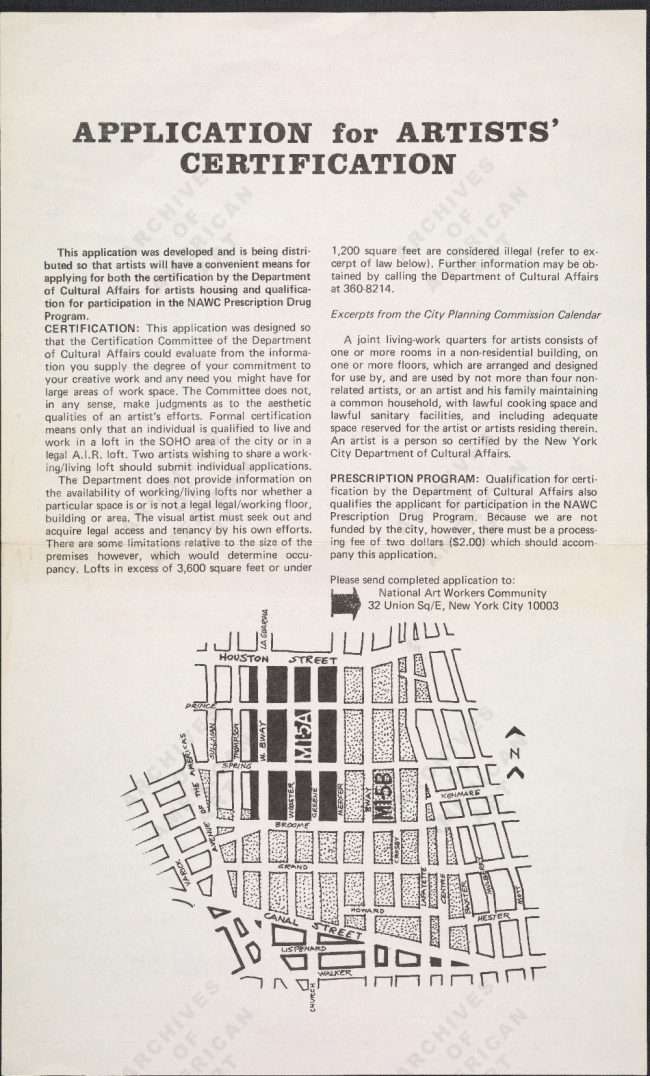
Application for Artists’ Certification | SoHo Artists Association Records, 1968-1978. Archives of American Art, Smithsonian Institution
Even in the beginning, there were non-artists who slipped in through the cracks and legitimate artists who were rejected, and as time went on, strict adherence to the criteria relaxed. In the present day, there are only a few hundred certified artists living in SoHo, although hundreds of non-certified artists still live and work in the neighborhood. Every non-artist who moves into SoHo today could theoretically be told to move out unless he or she can prove artistic legitimacy, but the probability of that aspect of the law being enforced is low.
Although these zoning changes secured the status of artists who were loft owners, they did not provide protection for renters. Building owners began taking advantage of rising real estate values by raising rents or attempting to evict artists. The Lower Manhattan Loft Tenants Association formed in 1978 to fight for the rights of renters, which eventually resulted in the enactment of Article 7C of the New York State Multiple Dwelling Law in 1982. This “Loft Law” assured that tenants in applicable buildings could not be evicted and required building owners to obtain a certificate of occupancy. The law was set to expire in 1992 but was continuously extended and then made permanent in 2010.
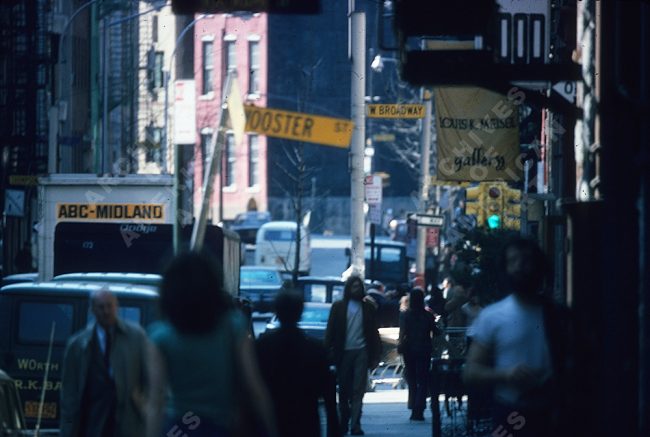
Prince Street in Soho, 1976 | Photo: Robin Forbes, Robin Forbes’ slides of Soho, Archives of American Art, Smithsonian Institution
The SoHo Alliance, founded in 1981, like its predecessor the SAA, is an advocacy group that seeks to protect the interest of artists. The economic and social shifts that took place in SoHo from the early 1980s through the present are reflected in the shift in focus of the SoHo Alliance from artist-related issues to more general quality of life issues during this period. The change in the socio-economic makeup of SoHo residents brought with it commercial development. Art galleries began to move out of the neighborhood in the 1980s and 1990s, mostly to Chelsea where rents were more reasonable, and were replaced by high-end boutiques, restaurants, bars, and nightclubs. Nightlife destinations brought unwelcome street noise, and the SoHo Alliance fought hard against the issuing of new liquor licenses. Other concerns of the Alliance include the crowding of sidewalks due to a proliferation of street peddlers on weekends and a parking shortage due to new construction on former parking lots.
SoHo currently boasts some of the most expensive real estate in New York City, which, in turn, is one of the most expensive cities in the world. Rents and property values have skyrocketed over the past forty years, and many of the artists who made SoHo a desirable neighborhood moved to other areas due to rising rents and other financial constraints. Some who were owners of their buildings, purchased early on at rock-bottom prices, saw their property value increase tenfold or more and decided to sell their lofts at a large profit and move away by choice.
At one time the term “SoHo” referred to “the other side of the tracks,” a dicey area where artists lurked in the shadows in fear of being evicted, but now SoHo is used as an adjective to describe an aesthetic or a lifestyle that is glamorous and hip with a dash of bohemia mixed in, as in SoHo-style loft or SoHo chic. The name SoHo has gone from describing an industrial wasteland to the stomping grounds of the well-heeled. This underscores the importance of what the Judd Foundation has done with 101 Spring Street. As a museum, gallery, historic landmark, education space, memorial, archive, and a home combined into one, 101 Spring Street is the physical embodiment of the ideology formulated by Judd and his peers that fused art with everyday life. To enter is to step into a memory, perfectly preserved, that reflects the rich architectural, social, and urban history of SoHo and the evolution of a new mode of city living that continues to thrive to this day.
The views expressed here are those of the authors only and do not reflect the position of The Architectural League of New York.